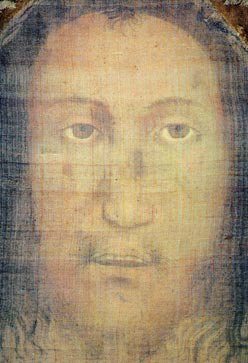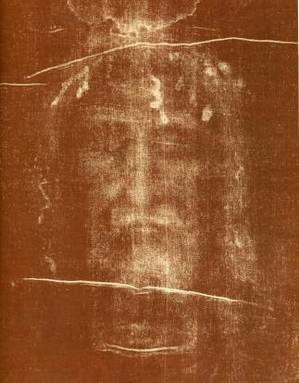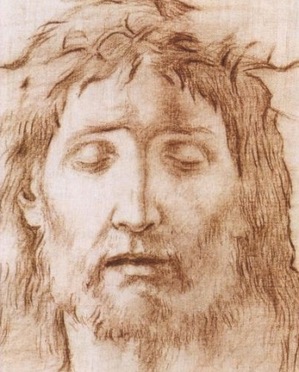Il Volto dei Volti: Quello di Cristo
 The Face of All Faces — That of Christ
The Face of All Faces — That of Christ
Our Holy Father’s Message for 2011 World Day of the Sick
The Vatican press office published this message Saturday. It arrives in the midst of our preparations for Christmas and thus risks being overlooked or put aside to be read later, and then forgotten. I would encourage everyone to read it now and then return to it for the Feast of Our Lady of Lourdes, the World Day of the Sick. In reading this message of Our Holy Father, I cannot help but think of so many friends who are called, in the Holy Father’s own words, to “feel the nearness of this Heart [of Jesus] full of love, and draw from this font with faith and with joy, praying: “Water from the side of Christ, wash me. Passion of Christ, strengthen me. O good Jesus, hear me. In your wounds, hide me” (Prayer of St. Ignatius of Loyola). The themes of this message are familiar to the readers of Vultus Christi: the Holy Face of Christ, His glorious Wounds, His Sacred Heart. The Holy Father even recalls his pastoral visit to Turin where he contemplated the suffering Face of Christ imprinted on the Sacred Shroud. His Eminence, Fiorenzo Cardinal Angelini, so devoted to the Holy Face of Jesus and to the care of the sick, will be delighted, I am sure, to see the connection made by the Holy Father between the “Volto dei volti” — the Face of all faces — and the countenances of all our sick brothers and sisters.
Would it not be a wonderful thing if various charitable organizations, such as the Knights of Columbus, offered to place a suitable image of the Face of Jesus (such as that of the Sacred Shroud, or of Manoppello) in every Catholic Hospital room, or at least in the chapel of every Catholic hospital? Saint Thérèse, in the final days of her illness, asked that an image of the Holy Face be attached to her bed curtains. Even when the very sick are unable to formulate prayers, they can find great comfort in gazing upon an image of the Holy Face, and in uniting their weakness and suffering to the weakness and suffering of Christ.
Dear brothers and sisters!
Care for the Suffering
Every year, on the occasion of the memorial of the Blessed Virgin of Lourdes, which is celebrated on Feb. 11, the Church proposes the World Day of the Sick. This circumstance becomes, as the venerable John Paul II desired, the propitious occasion to reflect on the mystery of suffering and, above all, to make our communities and civil society more sensitive to sick brothers and sisters. If every man is our brother, much more are the weak, the suffering and those needful of care, and they must be at the center of our attention, so that none of them feel forgotten or marginalized; in fact, “the true measure of humanity is essentially determined in relationship to suffering and to the sufferer. This holds true both for the individual and for society. A society unable to accept its suffering members and incapable of helping to share their suffering and to bear it inwardly through ‘com-passion’ is a cruel and inhuman society” (Spe Salvi, No. 38). May the initiatives that individual dioceses promote on the occasion of this day be a stimulus to make care for the suffering more and more effective, also in view of the solemn celebration that will take place at the Marian shrine in Altötting in Germany.

The Suffering Countenance of Jesus
1. I still have in my heart the moment when, during the course of the pastoral visit to Turin, I was able to pause in reflection and prayer before the sacred Shroud, before that suffering countenance, that invites us to meditate on him who took upon himself man’s suffering of every age and place, even our sufferings, our difficulties, our sins. How many faithful over the course of history have passed before that sepulchral winding sheet, which covered the body of a crucified man, which in everything corresponds to what the Gospels transmit about the passion and death of Jesus! Contemplating him is an invitation to reflect on what St. Peter writes: “By his wounds we have been healed” (1 Peter 2:24).
The Wounds of Christ: Sign of Our Redemption
The Son of God has suffered, he has died, but he is risen, it is precisely because of this that those wounds become the sign of our redemption, of our forgiveness and reconciliation with the Father; they become, however, a test for the faith of the disciples and our faith: every time that the Lord speaks of his passion and death, they do not understand, they reject it, they oppose it. For them as for us, suffering is always charged with mystery, difficult to accept and bear. Because of the events that had occurred in Jerusalem in those days the two disciples of Emmaus walk along sadly, and only when the Risen One walks along the road with them do they open up to a new vision (cf. Luke 24:13-31). Even the apostle Thomas manifests the difficulty of believing in the redemptive way of suffering: “Unless I see the mark of the nails in his hands and put my finger into the nailmarks and put my hand into his side, I will not believe” (John 20:25).

The Holy Wounds: The Proof of Victorious Love
But before Christ who shows his wounds, his response is transformed into a moving profession of faith: “My Lord and my God!” (John 20:28). What was at first an insurmountable obstacle, because it was the sign of Jesus’ apparent failure, becomes, in the encounter with the Risen One, the proof of victorious love: “Only a God who loves us to the extent of taking upon himself our wounds and our pain, especially innocent suffering, is worthy of faith” (Urbi et Orbi Message, Easter 2007).
A Joy That Does Not Fear Pain
2. Dear sick and suffering ones, it is precisely through the sufferings of the Christ that we are able to see, with eyes of hope, all the maladies that afflict humanity. Rising, the Lord did not take away suffering and evil from the world, but he defeated them at their root. To the arrogance of Evil he opposed the omnipotence of his Love. He has shown us, then, that the way of peace and joy is Love: “As I have loved you, so must you love one another” (John 13:34). Christ, victor over death, is alive and in our midst. And while with St. Thomas we also say: “My Lord and my God!” we follow our Lord in readiness to spend our life for our brothers (cf. 1 John 3:16), becoming messengers of a joy that does not fear pain, the joy of the Resurrection.
Consolation in All Suffering
St. Bernard said: “God cannot suffer, but he can suffer with.” God, who is Truth and Love in person, wanted to suffer for us and with us; he became man to suffer with man, in a real way, in flesh and blood. Into every human suffering, then, there has entered One who shares suffering and endurance; he offers consolation in all suffering, the consolation of the participating love of God, which makes the star of hope rise (cf. Spe salvi, 39).
I repeat this message to you, dear brothers and sisters, so that you become witnesses through your suffering, your life and your faith.
Divine Life Flows from the Pierced Heart of Jesus
3. Looking forward to the meeting in Madrid, in August 2011, for World Youth Day, I would also like to address a special thought to young people, especially those who live the experience of sickness. Often, the Passion and the Cross of Jesus cause fear, because they seem to be the negation of life. In reality, it is exactly the contrary! The cross is God’s “yes” to mankind, the highest and most intense expression of his love and the source from which flows eternal life. From the pierced heart of Jesus this divine life flows. He alone is capable of liberating the world from evil and make his kingdom of justice, of peace and of love grow, the kingdom to which we all aspire (cf. Message for World Youth Day 2011, 3).
Seeing and Meeting Jesus
Dear young people, learn to “see” and to “meet” Jesus in the Eucharist, where he is present for us in a real way, to the point of making himself food for the journey, but know how to recognize and serve him also in those brothers who are poor, sick, suffering and in difficulty, who have need of your help (cf. ibid., 4). To all of you young people, sick and healthy, I repeat the invitation to create bridges of love and solidarity, so that no one feels alone, but near to God and part of the great family of his children (cf. General Audience, November 15, 2006).
The Sacred Heart of Jesus
4. Contemplating Jesus’ wounds our gaze turns to his most sacred Heart in which God’s love manifests itself in the supreme way. The Sacred Heart is Christ crucified, with his side opened by the lance, from which blood and water flow (cf. John 19:34), “symbol of the sacraments of the Church, that all men, drawn to the Heart of the Savior, might drink from the perennial font of salvation” (Roman Missal, Preface for the Solemnity of the Most Sacred Heart of Jesus). Especially you, dear sick ones, should feel the nearness of this Heart full of love and draw from this font with faith and with joy, praying: “Water from the side of Christ, wash me. Passion of Christ, strengthen me. O good Jesus, hear me. In your wounds, hide me” (Prayer of St. Ignatius of Loyola).

Mary, Health of the Infirm and Consoler of the Suffering
5. At the end of this message of mine for the next World Day of the Sick, I would like to express my affection to each and every one, feeling myself a participant in the sufferings and hopes that you have daily in union with Christ crucified and risen, that he give you peace and healing of the heart. May the Virgin Mary keep watch over you together with him. We invoke her confidently under the titles Health of the Infirm and Consoler of the Suffering. At the foot of the cross there is realized through her Simeon’s prophecy: her Mother’s heart is pierced (cf. Luke 2:35). From the abyss of her pain, a participation in her Son’s, Mary is made capable of accepting her new mission: to become the Mother of Christ in his members. In the hour of the cross Jesus presents her to all of his disciples: “Behold your son” (cf. John 19:26-27). The maternal compassion for the Son becomes maternal compassion for each one of us in our daily sufferings (cf. Homily at Lourdes, Sept. 15, 2008).
The Face of Christ
Dear brothers and sisters, for this World Day of the Sick, I also invite the political authorities to invest more and more in health systems that are a help and a support for the suffering, above all the poorest and the most needy, and, addressing all the dioceses, I offer an affectionate greeting to the bishops, the priests, consecrated persons, seminarians, health workers, volunteers and all of those who dedicate themselves with love to care for and sooth the wounds of every sick brother or sister, in hospitals or nursing homes, in families: in the faces of the sick know how to see always the Face of faces — that of Christ.
I assure everyone a remembrance in my prayer, while I impart to each of you a special apostolic blessing.
From the Vatican, Nov. 21, 2010, Feast of Christ the King of the Universe.
BENEDICTUS PP XVI
